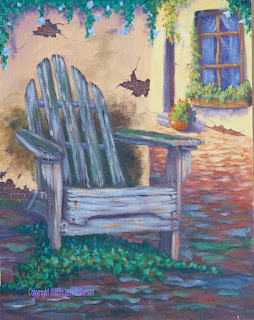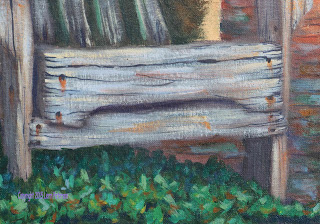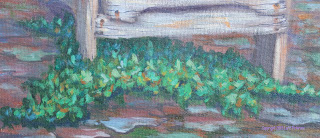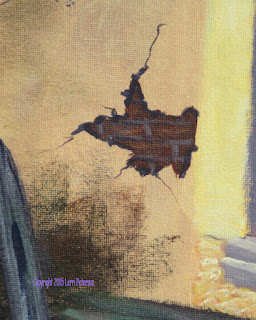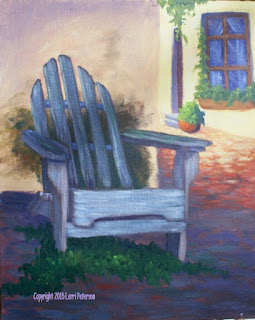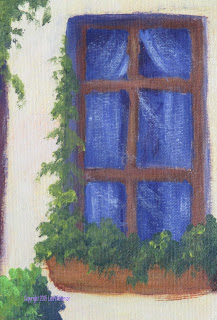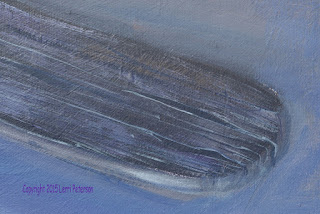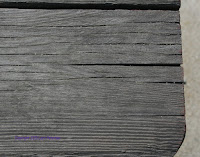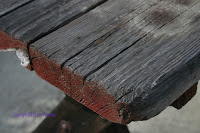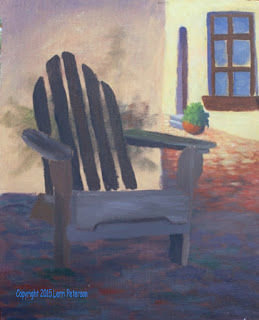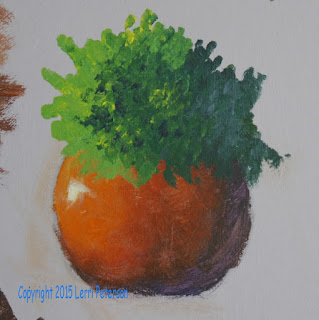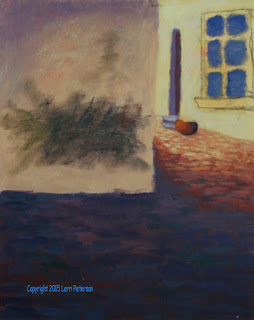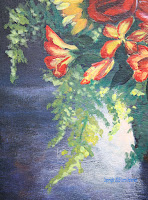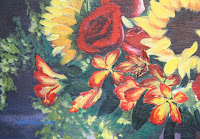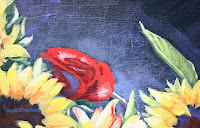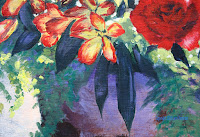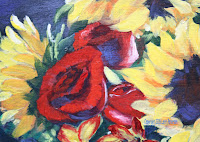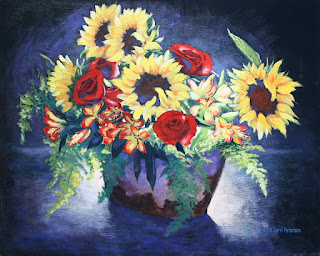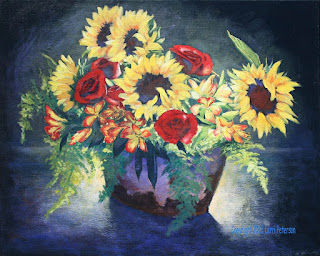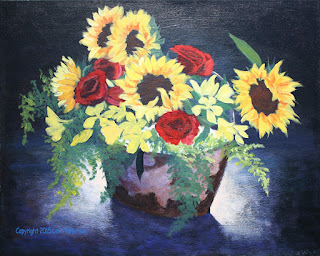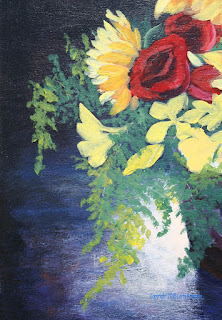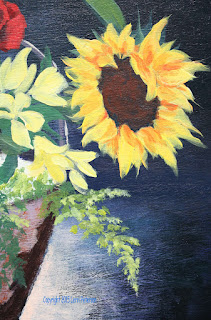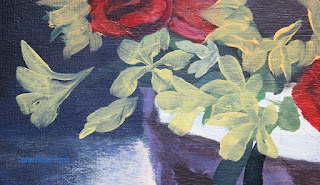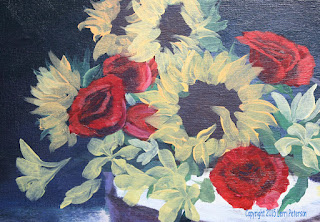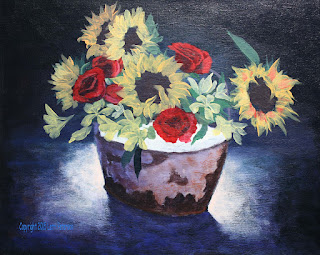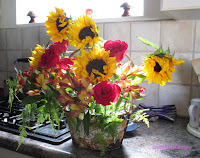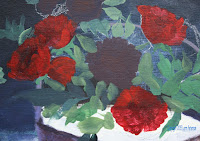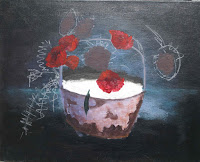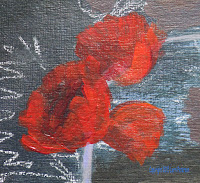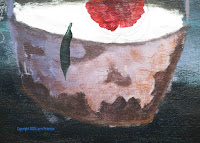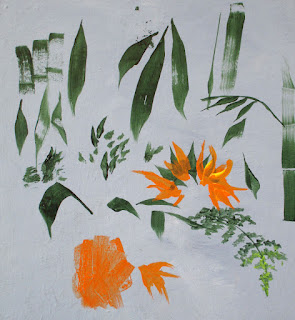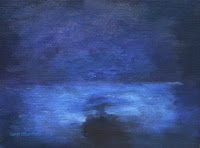You should have your
entire canvas under painted at this point, now we're going to start working on
some of the details.
First I wanted to add
another layer of color to the shadowed wall it's very similar to what is there but
just slightly lighter than the original shadowed yellow color. Remember that
color started out with the yellow and white and a little touch of orange plus a
little touch of purple to gray and cool the yellow color. If it gets too dark
you will want to add just a bit more white so that the color is lighter than
the wall is now and maybe a little more yellow, you just wanted a little bit
lighter than what it is.
I was using a number 6
flat bristle brush and I had very little paint or water on my brush, this is
called dry brush. The key part of this is very little water. If you can squeeze
the bristles and see moisture it's too wet and you need to take your paper
towel and dry it off even more before you pick up paint, even after you've
picked up paint if your paint was rather soupy you will have to squeeze at the
base of the bristles with your paper towel to get off any excess moisture.
Using a scumbling stroke
I lightly went over my stuccoed wall with this new color it will make it just a
little bit lighter but I don't want to cover up everything that is already
there I just want to add a lighter color to help create the texture of stucco
do not cover everything you want some of that underpainting to show through.
While this was drying, I
did a demo on how to paint the little pot by the door. Working either way from
light to dark or from dark to light, it’s your choice, (I have done it both
ways on many occasions) for this purpose I will start with the light colors and
move to the shadows I will be working wet into wet, but this is by no means the
ultimate in how to create this effect.
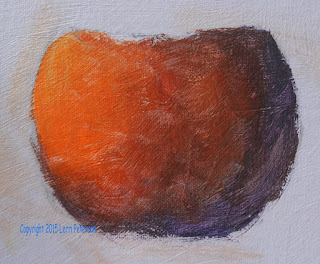
Starting on the light
side I used orange with a touch of burnt sienna and even a little yellow and
scrubbed in the color starting at the outside edge and working to about a third
of the way across and about two-thirds the way down the pot. While the paint is
still wet you pick up more burnt sienna then starting just at the edge of the
area you just painted start blending in the burnt sienna to the previous area
and about another third of the way across all the way down and back up the
bottom of the first area blending in that lighter area to make the bottom part
of it darker. Next, along with the burnt sienna pick up a little dioxazine
purple and mix that starting at the edge of the burnt sienna blending the
darker color in and blending blending it all the way around to the shadowed
sided and also blend that color on the bottom of the pot to create the shadow
on the bottom side of the pot. At the very edge of the pot, pick up a little
more purple and a little touch of blue for your darkest areas which will be the
backside of the pot and where the pot is sitting on the walkway. This should
give you the illusion of a round pot. Remember, I didn't paint this like a wall,
my brush strokes were very irregular, more like dabbing and scumbling but I
followed the curves of the pot, this is as important as the gradation in color.
If you want to put a little highlight on the pot, just used a little touch of
yellow and white into the light area of the pot where you want the highlight to
be.
I want you to look at
your reference photo, that is the actual photo of chair not anything we have
done in class or the prototype I did before class, but the actual photograph. I
want you to notice right behind the chair there is some nasty looking mold or
something growing on the side of the building, things like this add character
to your painting and while you do not have to do this if you don't want to I
like to do it because it creates a more natural looking environment. It's very
organic in shape and nature, also note that it is not a nice solid evenly
spaced square on the wall it is very irregular, that is our goal when we paint
this.

With hooker’s green as
my base I added touches purple, blue, Sienna, orange, yellow… just anything to
make a really nasty looking green color that is perfect mold color. Again this
is going to be a dry brush technique so once you load your brush up make sure
that there is little paint on it and no water, you're going to scumble this on
as well. You want breaks and irregular sides to this shape and darks and lights,
it's not a solid thing it's a living thing, some of it's been there a long time
some of its been there only months and has not covered completely so don't feel
that you have to cover completely when you are painting.
Once you have the mold
on your wall we are next going to start putting in the idea of cobblestones or
flagstones in the walkway. This is by no means the finished look to this
walkway we're just starting to create the effect of a rough cobblestone walk we
will do this in layers as with everything else.
Starting in the back by
the stairs I was using my number for flat bristle brush which has morphed into
more of a filbert because of all the scrubbing that just means it has more of a
point than being flat it's perfect for this if you want to use a round brush it
might help you create this effect but use a bristle brush not a Sable brush at
this point.
Using the yellow and
white I had mixed earlier - that is gesso with just enough yellow in it to tint
it - add a little touch of orange, you want a nice bright sunny color. You will
be making small flat strokes that will be closer together in the back and as
they come forward they will become a little longer and a little further apart. Remember:
When things go into the distance they get smaller and closer together and grayer
in color. Right now we are just going to concentrate on the smaller and closer
together. Make the shapes irregular and don’t line them up in perfect little
rows, if these are cobblestones or flagstones they are not going to be nice,
even well-spaced tiles, they are going to be random in size and shape so you
want your brush strokes to also be random in size and shape.
There is a shadow being
cast by the shadowed wall on the left hand side so you will have to be aware of
this and when you come to the shadowed area, you're going to be adding more
orange, touches of red, touches of Siena, and the more you come into the
shadows you will add touches of blue and purple to your color. You want a
gradation of value and color starting in the lightest area and then
transitioning to the cool shadows. Also, as you are coming forward remember to
make your strokes a little bit longer a little bit further apart, they're still
flat so you don't want to make them to round, you do want to make the more oval
shapes or long so they remain looking flat.
In the shadow areas
you're going to continue this textured pattern, but start adding some other
colors as you go. You can add green; you can add some blues or purples; you can
even add reds and oranges and sienna, you're just going to make shapes in this
dark part of the walkway, we will come back later and define the stones better,
for now all we're doing is creating some interesting shapes and textures again
this is not the final look to this just part of the under painting.
Try to get your painting
to this point because next class we may be sketching in the chair we need to
get as much of this done now so that the chair can go on in the next lesson or
two do the best you can keep painting and I will see you in class.
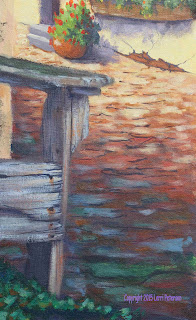 I just suggested detail in the distant cobble stones. They are too far in the background to see much detail and those of you who have done detail, it takes away from your subject the chair.
I just suggested detail in the distant cobble stones. They are too far in the background to see much detail and those of you who have done detail, it takes away from your subject the chair.